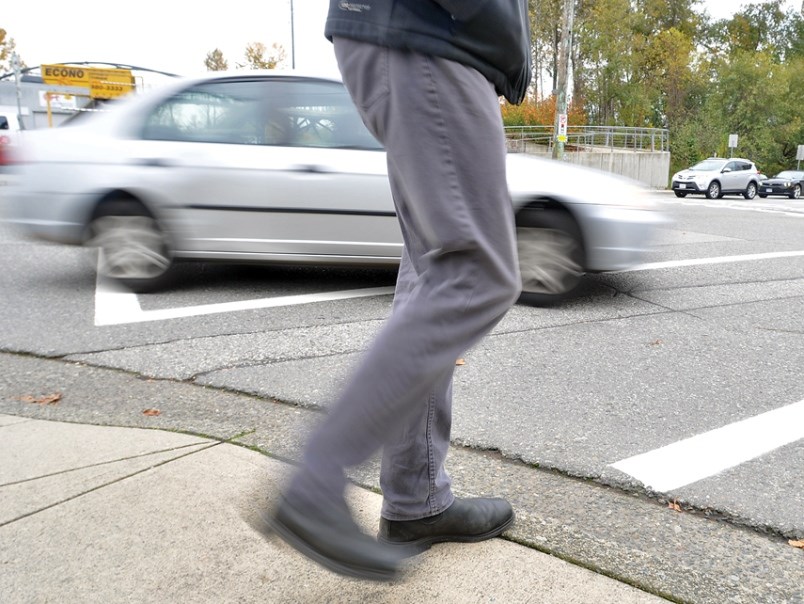Road safety as a public health issue certainly fuels some lively debate.
The news that the North Shore’s medical health officer is calling for a reduction in speed limits on neighbourhood streets to 30 kilometres per hour has provoked both cheers and jeers, especially online.
Public reaction seems to fall into one of two camps. First, those who correctly point out that risking lives isn’t worth the few seconds saved by not slowing down. On the other hand, there are those who also correctly point out that simply putting up a sign with a slower speed limit doesn’t actually solve anything.
Here’s what we know. Over the last several years, drivers have become better protected by their cars. Never mind the old adage of “They don’t make ‘em like they used to,” you’re far better off having a crash in a modern Toyota Corolla than in an old Chevy land yacht. Cars are safer than ever.
Those not protected by crumple zones and steel beams, however, have not enjoyed a similar reduction in the number of injuries. Pedestrians and cyclists are still being injured and killed at unacceptable rates. It’s not like we’re talking about darting jaywalkers either – many pedestrians are actually hit while crossing in marked crosswalks.
Much has been made of the rise of the petextrian – headphones in, eyes on a screen – paying more attention to composing their tweet than on their surroundings. Distracted walking has risen at the same level as distracted driving, but it’s worth pointing out that they’re not weighted equally. A distracted pedestrian is really only a danger to themselves, where a distracted driver is a danger to pretty much everybody.
Thus, the slowing of traffic to allow both sides more time to see each other and navigate the roads safely makes sense overall. However, there are more than a few frustrations to overcome.
First, simply lowering a speed limit doesn’t necessarily lower the speed of traffic. One need only look at various parts of the Upper Levels highway to see how road design dictates people’s speed more than the limit. When it’s not a parking lot due to volume, the widening of Highway 1 to six lanes near Lonsdale always seems to speed up westbound traffic that has slowed down between the top of the cut and the Lonsdale exit.
Where the road squeezes together and curves left and right, people slow down. When it clears ahead, they speed up. The limit is theoretically the same in both cases, but people push the envelope when they feel safe to do so.
So, reducing speeds on neighbourhood streets will take more than just a sign or two, and this can be a source of frustration for conscientious drivers. It’s basically the teacher giving everyone detention because one student is running around the class like a maniac. Changing a number on a sign isn’t going to stop the thoughtless, but it will make the already responsible grumble. Further, if the posted limit doesn’t seem to relate to the safe flow of traffic, people will tend to ignore it more and more as time goes on.
Speed limits alone won’t make the difference, but clever road design will. There are all sorts of traffic calming effects that can be designed into a neighbourhood, everything from speed tables to speed bumps, curbs that extend into the road, and so called “road diets” or the removal of a lane.
Further, there are all manner of improvements that can be made to crosswalks themselves. Some of the simplest include raising the crosswalk to curb height and shortening the distance travelled by extending a curb into a pinch point. Some more radical ideas include banning right hand turns entirely in certain areas – this probably should already be implemented more widely in the downtown core.
All of these solutions require money, planning, and engineering, and are thus quite a bit harder than simply sticking up a sign with a new number on it. However, the data is already out there with respect to where the worst intersections are, so perhaps we could begin there.
Further, maybe we could adopt a morbid practice used in Ireland. Any time you enter a county there, you’ll see a sign updating drivers as to the number of road deaths recently. Signs warning both drivers and pedestrians of the worst intersections could help alert both to pay even more attention than they should already be paying.
And lastly, as this is the automotive section of the paper, it behooves us as drivers to ask first what our responsibilities are, before worrying about whether we’re being unfairly blamed. Even if we already feel we’re doing a good job behind the wheel, there’s always room for improvement: make sure you’re not turning left into an occupied crosswalk, make sure you’re watching for a pedestrian to step off the curb late, never pass a vehicle that’s slowing near an intersection in case there’s someone crossing you can’t see.
Perhaps you’ve had an incident where an inattentive or dark-clad pedestrian has made you have to jump on the brakes. That’s frustrating, but in the end, it doesn’t matter; the onus lies on us as drivers to take extra care, as it is not us who will get hurt the most. One thing all critics of the proposed speed limit changes are correct about: lower limits alone won’t make people safer. But we can.



